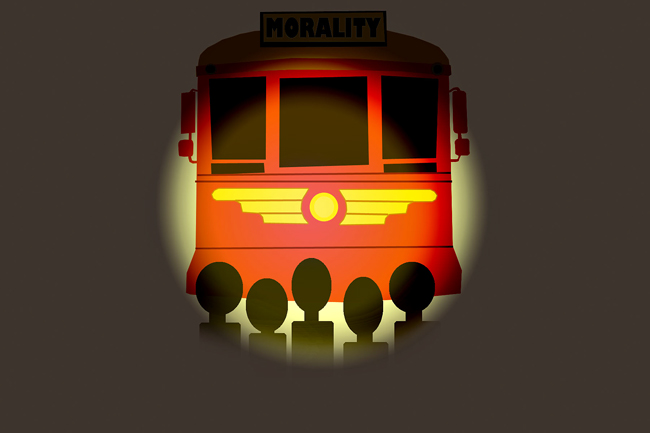A runaway trolley heads down the tracks, aimed at five innocent bystanders. In front of you lies a switch. Pulling it diverts the trolley to another track, where it will only hit one person. You have five seconds — do you pull the switch?
If you are like the majority of people — around 90 percent, depending on the study you reference — you’ll say you will, defending your decision with the utilitarian stance that saving five lives is worth sacrificing one.
What if there is no switch? Instead, you are above the track, standing on a bridge. There is a large man beside you, and if you push him off, he will fall in front of the train and block it from hitting the five people.
It’s not such an obvious choice now, is it?
Even though the end result of the action is the same — one dead, five saved — the second scenario tests the limits of our moral sensibilities.
These are both variations on the “Trolley Problem,” devised by Philippa Foot, former University of California, Los Angeles philosophy professor, and popularized by Judith Thomson, a philosophy professor at the Massachusetts Institute of Technology.
The explanation of why the first situation is acceptable and the second is not usually runs along the lines of circumstance. The death of one is an unfortunate consequence in the first case and a method of rescue in the other.
A recent study removed some of the artificiality of the trolley problem by providing subjects with a virtual reality headset, a real switch and auditory consequences. A paper from the study describes “screams of distress from either one or five agents became audible depending on the direction of the boxcar and the placement of the agents. Screaming was cut short at the moment of impact, and the visual environment faded to black.”
The high-tech reworking didn’t change much. The results were largely the same as the survey answers. But the researchers did hit upon something that the thought experiment ignored: human error.
In an alternate group, participants saw the train headed toward the one bystander and had the choice to flip the switch and kill five innocents. Of the 146 subjects in this group, 17 chose that option.
Eight of the participants said they didn’t notice the people on the other track, and some of them apologized to the corpses they inadvertently created.
Even in virtual form, these scenarios get to the heart of our innate morality, which is difficult to define, but feels absolute. Though these thought experiments are completely artificial, their directness has the capacity to reveal our deeply held beliefs and inform more realistic issues.
In Thomson’s “Violinist,” for instance, you wake up and discover a society of music lovers has plugged you into a famous violinist, and you will act as his life support. After nine months, he can safely detach and live on his own, but if you unplug before then, he dies.
Here, Thomson has created a parallel to the abortion debate, but one in which the issue of personhood is removed. That being the case, is it acceptable for you to detach your body from another human who is dependent on it?
The scenarios are silly, but it’s not difficult to see their implications: Regardless of if we will ever need to detach ourselves from a famous violinist, it’s important to know whether the society we’re in would deem it murder if we did.















